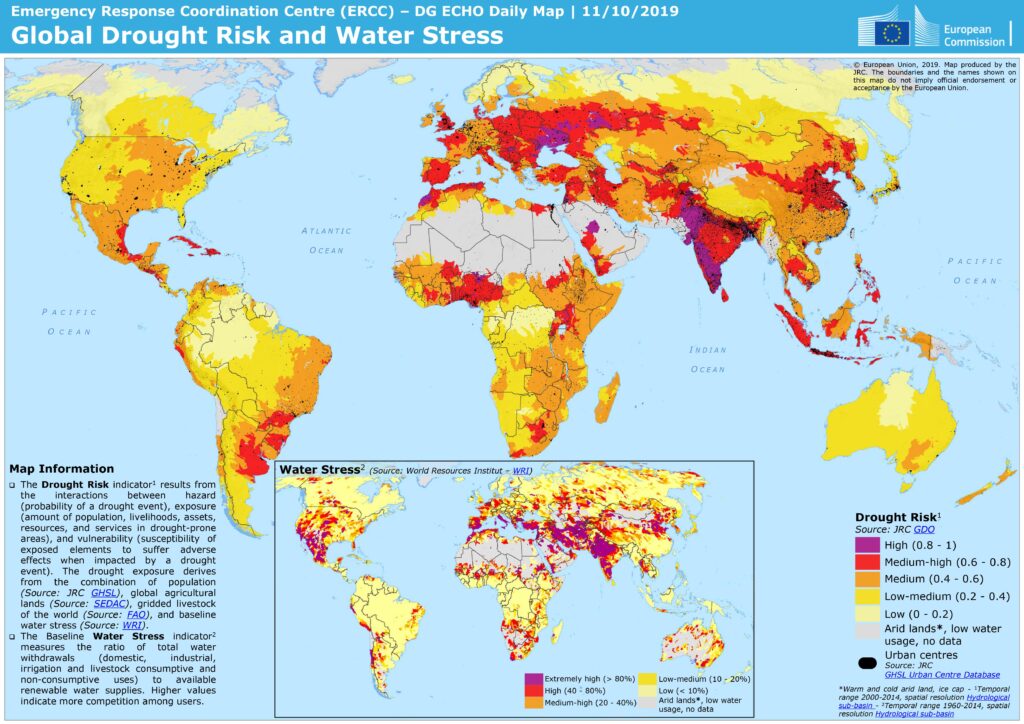As the planet warms and weather patterns shift, drought has become a more frequent and severe challenge across many parts of the world. Understanding where droughts are most likely to occur and the impact they have on these regions is crucial for effective management and mitigation strategies. This blog explores some of the most severely drought-prone areas globally and discusses the underlying causes and potential solutions to this escalating problem.
Understanding Drought and Its Global Impact
Drought is a prolonged period of deficient rainfall that leads to a series of water shortages. It’s categorized into several types based on its impact and characteristics:
- Meteorological drought is based on the degree of dryness and the duration of the dry period.
- Agricultural drought links various characteristics of meteorological or hydrological drought to agricultural impacts, focusing on soil water deficits and how it affects crop production.
- Hydrological drought is identified in water sources like reservoirs, aquifers, and rivers, considering the delay in precipitation shortages affecting water supply.
- Socio-economic drought occurs when water supply is unable to meet human and environmental water demands, including economic goods production.
Regions Highly Affected by Drought
Several regions around the globe are particularly vulnerable to drought conditions. These include:
- India: Facing both meteorological and agricultural droughts, often leading to severe impacts on its massive agricultural sector.
- Eastern Europe: Experiences frequent dry spells affecting agriculture and water supply.
- Northeast China: Regularly struggles with significant droughts affecting millions of people and vast tracts of agricultural land.
- United States: Particularly in the southwest and central plains, droughts are a major concern, impacting everything from large-scale agriculture to urban water supplies.
- Southern Brazil and Northern Argentina: These regions face recurrent agricultural droughts, threatening their crucial agricultural output.
- Central Asia: Increasingly facing severe hydrological and agricultural droughts due to overuse of water resources and climate variability.
The Impact of Drought
Droughts can lead to several long-term consequences:
- Economic: Significant losses in agriculture, increased food prices, and disruption of water-intensive industries.
- Social: Migration from stricken areas, increased poverty, and conflict over dwindling resources.
- Environmental: Loss of biodiversity, soil degradation, and reduced resilience of natural landscapes to recover from other environmental impacts.
Global Drought Risk and Water Stress: Understanding the Factors

Figure: Spatial colormap representing Global Drought Risk and Water Stress. Severe drought-prone regions include India, Eastern Europe, Northeast China, most parts of the USA, southern parts of Brazil, northern parts of Argentina, and Central Asia. This figure is taken from RelifWeb.
The Drought Risk indicator in the figure results from the interactions between hazard (probability of a drought event), exposure (amount of population, livelihoods, assets, resources, and services in drought-prone areas), and vulnerability (susceptibility of exposed elements to suffer adverse effects when impacted by a drought event). Exposure combines factors like population density, agricultural lands, livestock numbers, and baseline water stress, which measures the ratio of total water withdrawals to available renewable water supplies, indicating competition among users.
Mitigation Strategies and Global Cooperation
Effective drought management requires a multi-faceted approach:
- Sustainable water management: Enhancing the efficiency of water use and improving water conservation in agriculture, industry, and cities.
- International aid and cooperation: Ensuring that resources and knowledge are shared between countries to aid those most affected by drought.
- Innovation in drought prediction and monitoring: Utilizing satellite technology and AI to predict and monitor drought conditions, allowing for better preparedness and response.
Having read your posts. I believed you have given your readers valuable information. Feel free to visit my website UY5 and I hope you get additional insights about Marketing as I did upon stumbling across your site.